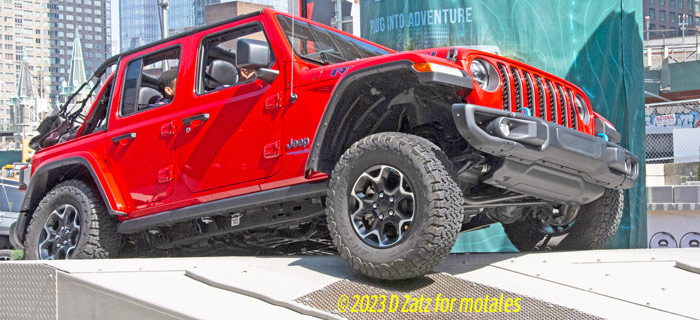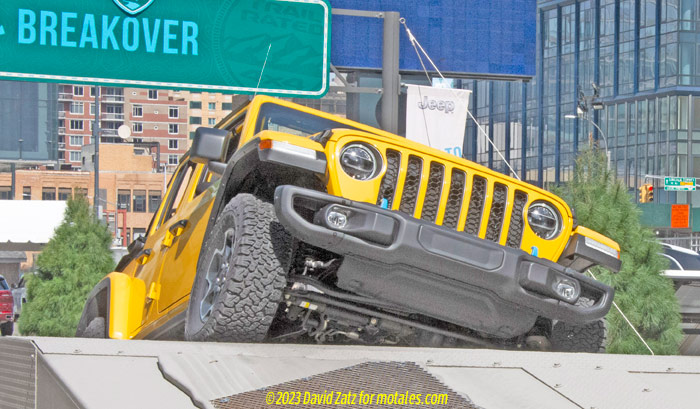When the first civilian Jeeps arrived, their solid axles in front and rear were common. It’s an easy design to modify, and it can be extremely capable for moving over obstacles, but it’s not the ideal for driving on pavement or dirt roads, which is why Jeep itself pioneered independent front suspensions in the 1960s. This is especially true when parts wear out; the steering wheel can shimmy (move side to side) uncontrollably, especially when the front wheels hit certain road conditions, such as a diagonal railroad track.
Jeep officials call it “resonance” or “vibration;” many owners call it “death wobble.” The problem can be severe, literally pulling the steering wheel from the driver’s hand. Some who tested numerous factory-fresh Wranglers and Gladiators said it was absent on some, and serious on others—we’ll talk about that later.

Respected Jeep modifier Norm Layton wrote that shimmy is often caused by putting on bigger wheels or tires or lift kits which change the front toe, caster, or camber. Other causes include a bad alignment, unbalanced tires, bent wheels, broken tire cords, worn shock absorber parts, and damage to steering parts or tie rod ends. It’s not only a Jeep issue, because it can show up on pickup trucks and other vehicles with solid front axles.
Some claimed that it persists because Jeep did not specify strong enough parts in recent models. It’s important to realize that all these parts are only strong enough for the original tires; tires with more mass present numerous problems to the suspension. He added that the Rubicon “is at the ragged edge of acceptable street and offroad suspension geometry motion.”
After a class action suit from owners of 2018-20 Wranglers and 2020 Gladiators, Jeep extended the warranty on the front suspension dampers to eight years or 90,000 miles. As Walt McCrystal pointed out, the steering damper is hydraulic, and if it is oil-covered but nothing above is leaking, some of the fluid has leaked out—which can cause the “death wobble.” A better damper was released in 2019.
Norm Layton opined that the steering damper was not a fix but “a band-aid used to mask issues with either worn components or poor design.” Jeep first started using them in the 1970s to deal with wider, heavier wheels and tires. This made sense: death wobble started becoming a serious issue in the 1960s with aftermarket lift kits. At the time steering was handled by a single rod from the Pitman arm to the tie rod; the tie rod was a single rod coupling the two knuckles. The 1984 Jeep Cherokee changed the setup somewhat.
Former Jeep suspension engineer Bob Sheaves agreed, noting that the steering dampers do “nothing except damp the motion by adding a variable-motion resistance to an already unstable system.” The real issue was flexing, through “material internal load paths, grain structure, and modulous of elasticity.”
Some believe that the real fix is a heavier-duty tie rod, drag link, and damper, installed at the factory. These would help as the vehicles grew older; allow for minor customizations; and ensure that stock vehicles never had “resonance” right from the factory.

“Ruptured Duck” pointed out that the suspension can be viewed as a stack of things that all vary. If normal tolerances are not controlled tightly enough, normal variations in the track bar bushings and mounting holes, ball joints, tire balance, wheel roundness, and so on could cause problems on brand new cars. Allpar commentor “valiant67” separately wrote that poor tolerances or quality control may be the issue—“people have found loose ball joint bolts on new Jeeps, for instance”—which would compound the problem.
Bob Sheaves pointed out that the steering knuckles are supplied by other companies, which may not use exactly the same materials as the design assumes; so the modeling of inputs may get the load paths wrong. The low (compared with CATIA) accuracy of FCA’s CAD software may also result in models that don’t properly predict the results; he recalled simulations in CATIA which: “in near real-time, the tie rod would deflect by varying degrees until it would fold itself into a U shape and finally break and shatter into pieces like a cartoon...so much for the accuracy of Unigraphics [NX software used by FCA for the current Wrangler].”
Overall, there are numerous possible solutions that stop short of the obvious one, which was adopted by Jeep’s latest hot competitor—using an independent front suspension.
Copyright © 2021-2025 Zatz LLC • Chrysler / Mopar car stories and history.
YouTube • Editorial Guidelines • Videos